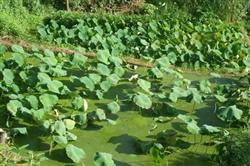Planting techniques of lotus root

First, what are the differences between the water level standards of deep-water lotus root and shallow-water lotus root, and how to adjust them in production? According to the adaptability of lotus root to water level, it can be divided into two ecological types: shallow water lotus root and deep water lotus root. Shallow lotus root is suitable for water level of 10-20 cm, and the maximum water-resistant depth is 30-50 cm. Deep-water lotus root is suitable for water level of 30-50 cm, and the maximum water-resistant depth is 1-1.2 m. The general principle of shallow lotus root water layer management is: front shallow, middle deep, back shallow. During the sprouting period from planting lotus root to the emergence of standing leaves, shallow water should be kept in order to increase soil temperature and promote germination. Generally speaking, it is better to keep the water layer 4-7 cm deep. With the emergence of standing leaves, the growth of lotus root stems and leaves gradually flourish, and the water layer should gradually rise to 12-15 cm. When the terminating leaf appears, it indicates that the lotus root begins to form, and the water layer should be gradually reduced to 4-7 cm to promote lotus root formation. The water level of deep-water lotus root is not easy to adjust, mainly to prevent flooding in the flood season, especially after the standing leaves are submerged, emergency drainage should be made within 8 hours to make the lotus leaves out of the water to prevent drowning. Second, how to use herbicides reasonably to get rid of weeds in lotus root ponds? In the growth process of lotus root, especially in the early growth stage of shallow water lotus root, there are many weeds in paddy field, such as eye grass, cow felt, dwarf mushroom, clover, four-leaf duckweed, black algae and so on, which affect the growth of lotus root and should be weeded in time. In the past, artificial ploughing and weeding was often used, which had a large workload and was easy to trample on the underground stem buds of lotus root. If chemical weeding is used, it will save labor and labor, and will not harm the lotus root. In recent years, through the research and experiment of scientific and technological personnel, some safe and effective methods of chemical weeding in lotus root field have been found out, which are being popularized in production. ⑴ selected 50% Weiluosheng EC, when the lotus root vertical leaf was 30 cm above the water surface, 100ml, first mixed with 5kg urea, then added 5kg fine soil, fully mixed, sprinkled into the field when the dew was dry, when the pesticide was applied, the lotus root field kept the water depth of 7-10cm and kept the water layer for more than a week, the effect was good, and the residual period could reach more than 1 month. ⑵ chooses 12.5% capping grass energy or 35% fine grass to kill 40 ml, add 40-50 kg of water, mix well, spray the leaves of weeds when the dew is dry, and have a significant effect on killing 3-4 leaf stage Gramineae weeds after 4 days.
- Prev

How to fertilize kidney beans
How to fertilize kidney beans
- Next

The technique of planting lotus root with terminal bud
In recent years, some farmers in China have replanted lotus root with higher output value in some low-lying fields. According to the investigation, lotus plague (also known as rot disease) occurred in some lotus fields, which is the main disease of lotus root. In general, the yield of diseased fields is reduced by 20%, and the serious ones are up to 60%, 80%. First, harm symptoms: Lotus plague mainly harms the underground stem, making it brown and rotten, first.
Related
- Where is it suitable to grow horseradish in China? it is expected to see the middle altitude horseradish in Alishan.
- How to prevent tomato virus disease reasonably? (Control methods included)
- Many people like to plant towel gourd on the balcony. What are the main points of this method and management?
- What crops can chili peppers be mixed with?
- Fertilization techniques and matters needing attention in Tomato
- What are the grafting techniques for peach seedlings in spring?
- Harm and control methods of root swelling disease of Chinese cabbage
- What are the pests of sweet potatoes? How to prevent and cure it?
- Symptoms, causes and Control methods of navel Rot in Tomato
- The cause of "Cucumber rotten bibcock" in Farmers' planting Cucumber and its Control Plan

